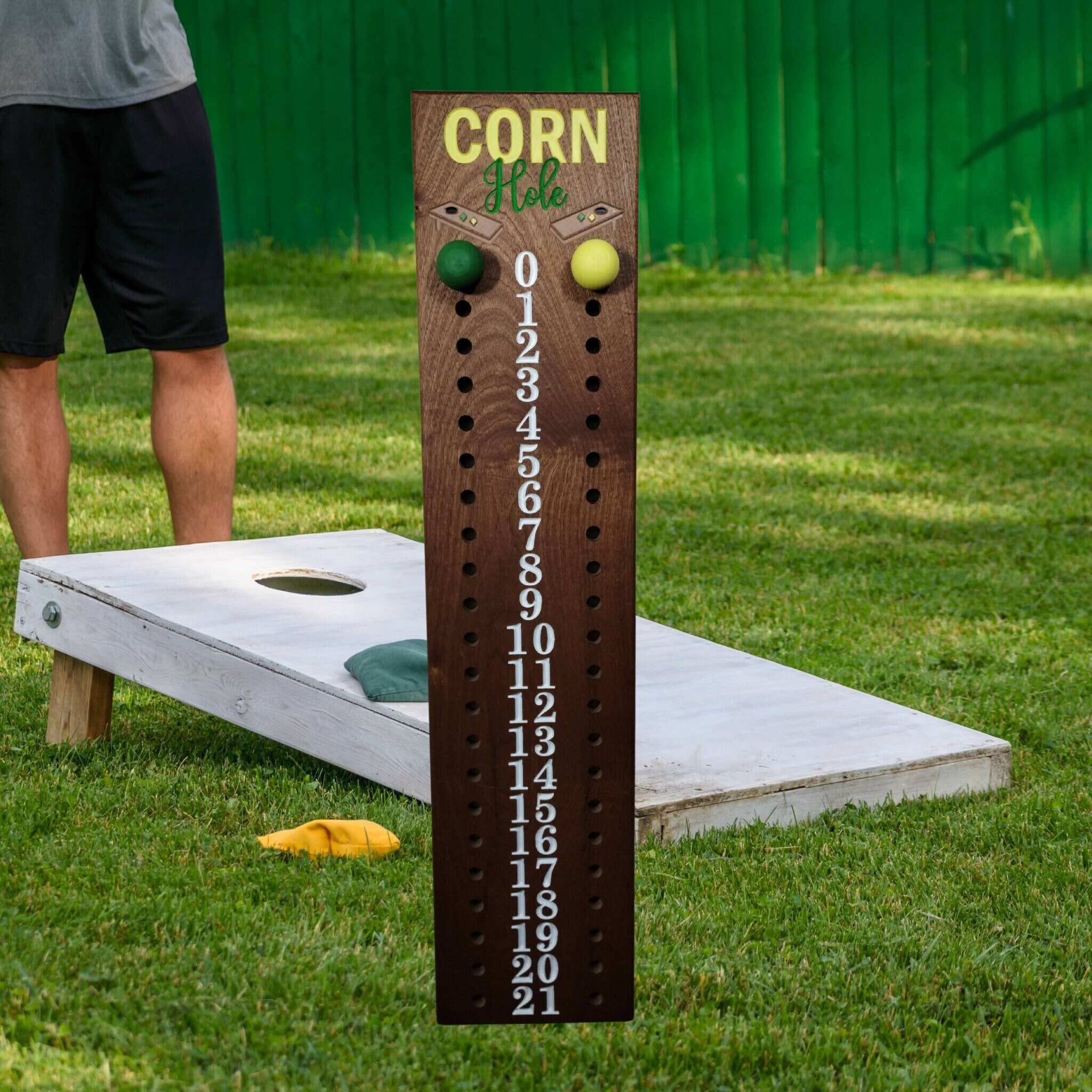A Comprehensive Guide to Keeping Score in Cornhole

Cornhole, also known as bags, is a beloved backyard game enjoyed by people of all ages. The game involves tossing bean bags onto a raised board with the goal of getting them into a hole or onto the board itself. While the game may seem simple, understanding how to properly keep score is crucial to ensuring a fair and competitive game.
In this guide, we’ll break down how scoring works in cornhole, providing examples and even a few diagrams to help you understand different scoring scenarios.
Scoring Basics
At its core, cornhole scoring is straightforward. The objective is to score points by getting your bags either into the hole or onto the board. Here’s how the points are awarded:
- 3 points: A bag that lands in the hole.
- 1 point: A bag that lands on the board.
- 0 points: A bag that touches the ground or bounces off the board.
To illustrate, if you throw a bag that lands in the hole, you earn 3 points. If the bag simply lands on the board, it’s worth 1 point. Any bag that fails to make it to the board (either by falling off or bouncing away) scores nothing.
Cancellation Scoring
In cornhole, the cancellation scoring method is used to determine how points are awarded after each inning. Here’s how it works:
- Both teams throw four bags each.
- After both teams have thrown all their bags, their scores for that round are tallied.
- The team with the higher score cancels out the lower team’s score. For example, if Team A scores 7 points and Team B scores 5 points, the difference of 2 points (7 - 5) is added to Team A’s score, while Team B scores nothing.
In other words, only the net score (the difference between the two teams’ points) is added to the total score. If the teams score equally, no points are awarded for that round.
Example of Cancellation Scoring:
- Team A: 2 bags in the hole (6 points), 1 bag on the board (1 point) = 7 points
- Team B: 1 bag in the hole (3 points), 2 bags on the board (2 points) = 5 points
In this case, Team A scores 7 points and Team B scores 5. The difference is 2 points (7 - 5), so Team A will add 2 points to their total score game score.
Scoring Scenarios: Putting It All Together
To really grasp how cornhole scoring works, let’s walk through a few more specific scenarios. These examples will show different situations you might encounter during a game.
Inning 1: Balanced Round
In this scenario, both teams are fairly evenly matched:
- Team A: 2 bags in the hole (6 points), 2 bags on the board (2 points) = 8 points
- Team B: 2 bag in the hole (6 points), 1 bag on the board (1 point) = 7 points
In this case, Team A scores 8 points and Team B scores 7 points. The difference between them is 1, so Team A will add 1 point to their total game score.
Scenario 2: No Score Round
Now, let’s look at an example where the teams have scored the same amount:
- Team A: 1 bag in the hole (3 points), 3 bags on the board (3 points) = 6 points
- Team B: 2 bags in the hole (6 points), 0 bags on the board (0 points) = 6 points
Since both teams have scored the same, the cancellation rule means no points are awarded in this round. The total game score does not change.
Scenario 3: One-Sided Round
Here’s an example where one team clearly outperforms the other:
- Team A: 3 bags in the hole (9 points), 1 bag on the board (1 point) = 10 points
- Team B: 0 bags in the hole (0 points). 1 bag on the board (1 point) = 1 point
In this case, Team A scores 10 points, and Team B scores just 1. The difference is 9 points, so Team A’s total game score increases by 9.
Winning the Game
In cornhole, a team wins the game as soon as they reach or exceed 21 points. There’s no need to land exactly at 21 points, so if a team goes over, they still win the game.
Example of Winning:
- Team A: 19 points
- Team B: 18 points
If Team A scores at least 2 points in the next round, they’ll meet or exceed 21 points and win the game.
Example Game
| Inning | Team A | Team B | Game Score |
|---|---|---|---|
| 1 | 7 | 5 | 2 - 0 |
| 2 | 3 | 6 | 2 - 3 |
| 3 | 6 | 3 | 5 - 3 |
| 4 | 4 | 2 | 7 - 3 |
| 5 | 3 | 0 | 10 - 3 |
| 6 | 4 | 6 | 10 - 7 |
| 7 | 6 | 2 | 14 - 7 |
| 8 | 5 | 3 | 16 - 10 |
| 9 | 6 | 1 | 21 - 10 (Team A wins) |
Breakdown of the Game:
- Inning 1: Team A scores 7, Team B scores 5. The difference is 2 points, so Team A earns 2 points. Game Score = 2 - 0.
- Inning 2: Team A scores 3, Team B scores 6. The difference is 3 points, so Team B earns 3 points. Game Score = 2 - 3.
- Inning 3: Team A scores 6, Team B scores 3. The difference is 3 points, so Team A earns 3 points. Game Score = 5 - 3.
- Inning 4: Team A scores 4, Team B scores 2. The difference is 2 points, so Team A earns 2 points. Game Score = 7 - 3.
- Inning 5: Team A scores 3, Team B scores 0. The difference is 3 points, so Team A earns 3 points. Game Score = 10 - 3.
- Inning 6: Team A scores 4, Team B scores 6. The difference is 2 points, so Team B earns 2 points. Game Score = 10 - 7.
- Inning 7: Team A scores 6, Team B scores 2. The difference is 4 points, so Team A earns 4 points. Game Score = 14 - 7.
- Inning 8: Team A scores 5, Team B scores 3. The difference is 2 points, so Team A earns 2 points. Game Score = 16 - 10.
- Inning 9: Team A scores 6, Team B scores 1. The difference is 5 points, so Team A earns 5 points. Team A reaches 21 points and wins the game. Game Score = 21 - 10.
Scorekeeping Options
When it comes to keeping track of your score in cornhole, there are several options depending on your preference and the level of formality in your game. For those who like a more traditional approach, physical scorekeeping devices such as scoreboards with pegs, clips, or chalkboards are popular choices. These devices make it easy to update scores after each inning. Alternatively, digital apps like Scorholio offer a convenient solution for scorekeeping, perfect for tournament play or competitive matches. For more casual players, it’s not uncommon to simply keep the score in their head, especially in informal backyard games where simplicity is key. Each method has its own advantages, so it’s all about finding what works best for your group.
Pro Tips for Scoring in Cornhole
- Consistency is Key: Make sure you understand the rules before starting a game. Consistently applying the cancellation rule will ensure fair play.
- Clear Communication: Always communicate with your opponent about the score, especially if there’s any confusion. Clear communication avoids mistakes.
- Use Scorekeeping Apps: Apps like Scorholio can streamline the process, track scores automatically, and help you focus more on playing.
Conclusion
Mastering the scoring system in cornhole is essential for enjoying the game to its fullest. Whether you’re playing casually in the backyard or participating in a more competitive setting, understanding how points are earned, the cancellation rule, and how to properly track your score will ensure the game runs smoothly.
